Kyung-Soo Kim
Ground-Aware Octree-A* Hybrid Path Planning for Memory-Efficient 3D Navigation of Ground Vehicles
Sep 05, 2025Abstract:In this paper, we propose a 3D path planning method that integrates the A* algorithm with the octree structure. Unmanned Ground Vehicles (UGVs) and legged robots have been extensively studied, enabling locomotion across a variety of terrains. Advances in mobility have enabled obstacles to be regarded not only as hindrances to be avoided, but also as navigational aids when beneficial. A modified 3D A* algorithm generates an optimal path by leveraging obstacles during the planning process. By incorporating a height-based penalty into the cost function, the algorithm enables the use of traversable obstacles to aid locomotion while avoiding those that are impassable, resulting in more efficient and realistic path generation. The octree-based 3D grid map achieves compression by merging high-resolution nodes into larger blocks, especially in obstacle-free or sparsely populated areas. This reduces the number of nodes explored by the A* algorithm, thereby improving computational efficiency and memory usage, and supporting real-time path planning in practical environments. Benchmark results demonstrate that the use of octree structure ensures an optimal path while significantly reducing memory usage and computation time.
A Novel 6-axis Force/Torque Sensor Using Inductance Sensors
May 14, 2025Abstract:This paper presents a novel six-axis force/torque (F/T) sensor based on inductive sensing technology. Unlike conventional strain gauge-based sensors that require direct contact and external amplification, the proposed sensor utilizes non-contact inductive measurements to estimate force via displacement of a conductive target. A compact, fully integrated architecture is achieved by incorporating a CAN-FD based signal processing module directly onto the PCB, enabling high-speed data acquisition at up to 4~kHz without external DAQ systems. The sensing mechanism is modeled and calibrated through a rational function fitting approach, which demonstrated superior performance in terms of root mean square error (RMSE), coefficient of determination ($R^2$), and linearity error compared to other nonlinear models. Static and repeatability experiments validate the sensor's accuracy, achieving a resolution of 0.03~N and quantization levels exceeding 55,000 steps, surpassing that of commercial sensors. The sensor also exhibits low crosstalk, high sensitivity, and robust noise characteristics. Its performance and structure make it suitable for precision robotic applications, especially in scenarios where compactness, non-contact operation, and integrated processing are essential.
Temperature Compensation Method of Six-Axis Force/Torque Sensor Using Gated Recurrent Unit
Feb 24, 2025Abstract:This study aims to enhance the accuracy of a six-axis force/torque sensor compared to existing approaches that utilize Multi-Layer Perceptron (MLP) and the Least Square Method. The sensor used in this study is based on a photo-coupler and operates with infrared light, making it susceptible to dark current effects, which cause drift due to temperature variations. Additionally, the sensor is compact and lightweight (45g), resulting in a low thermal capacity. Consequently, even small amounts of heat can induce rapid temperature changes, affecting the sensor's performance in real time. To address these challenges, this study compares the conventional MLP approach with the proposed Gated Recurrent Unit (GRU)-based method. Experimental results demonstrate that the GRU approach, leveraging sequential data, achieves superior performance.
Parameter Optimization of Optical Six-Axis Force/Torque Sensor for Legged Robots
Feb 11, 2025Abstract:This paper introduces a novel six-axis force/torque sensor tailored for compact and lightweight legged robots. Unlike traditional strain gauge-based sensors, the proposed non-contact design employs photocouplers, enhancing resistance to physical impacts and reducing damage risk. This approach simplifies manufacturing, lowers costs, and meets the demands of legged robots by combining small size, light weight, and a wide force measurement range. A methodology for optimizing sensor parameters is also presented, focusing on maximizing sensitivity and minimizing error. Precise modeling and analysis of objective functions enabled the derivation of optimal design parameters. The sensor's performance was validated through extensive testing and integration into quadruped robots, demonstrating alignment with theoretical modeling. The sensor's precise measurement capabilities make it suitable for diverse robotic environments, particularly in analyzing interactions between robot feet and the ground. This innovation addresses existing sensor limitations while contributing to advancements in robotics and sensor technology, paving the way for future applications in robotic systems.
A Compact Optical Six-Axis Force/Torque Sensor for Legged Robots Using a Polymorphic Calibration Method
Sep 20, 2023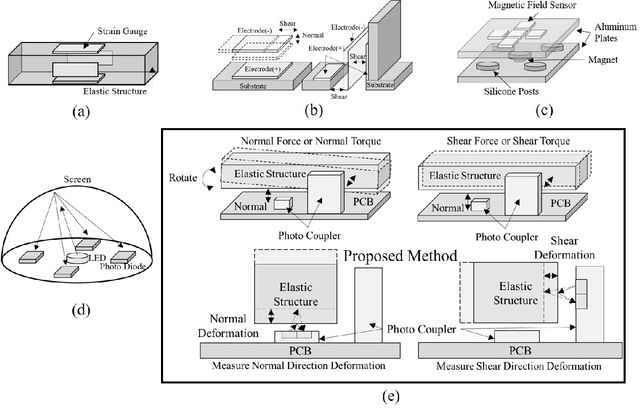
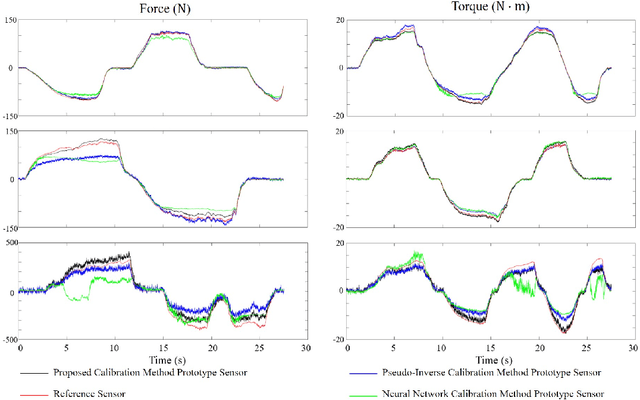
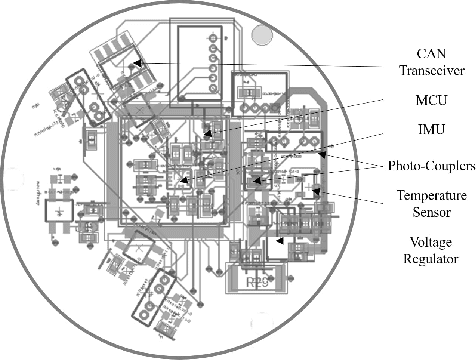
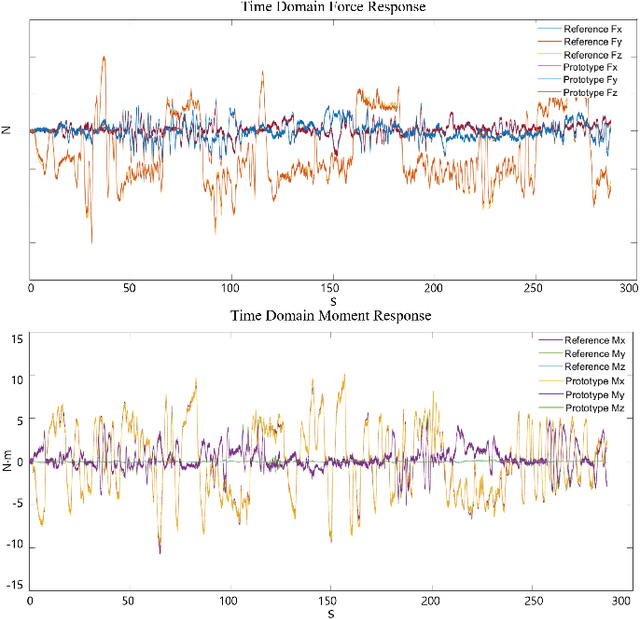
Abstract:This paper presents a novel design for a compact, lightweight 6-axis force/torque sensor intended for use in legged robots. The design promotes easy manufacturing and cost reduction, while introducing innovative calibration methods that simplify the calibration process and minimize effort. The sensor's advantages are achieved by streamlining the structure for durability, implementing noncontact sensors, and providing a wider sensing range compared to commercial sensors. To maintain a simple structure, the paper proposes a force sensing scheme using photocouplers where the sensing elements are aligned in-plane. This strategy enables all sensing elements to be fabricated on a single printed circuit board, eliminating manual labor tasks such as bonding and coating the sensing elements. The prototype sensor contains only four parts, costs less than $250, and exhibits high response frequency and performance. Traditional calibration methods present challenges, such as the need for specialized equipment and extensive labor. To facilitate easy calibration without the need for specialized equipment, a new method using optimal control is proposed. To verify the feasibility of these ideas, a prototype six-axis F/T sensor was manufactured. Its performance was evaluated and compared to a reference F/T sensor and previous calibration methods.
DualRefine: Self-Supervised Depth and Pose Estimation Through Iterative Epipolar Sampling and Refinement Toward Equilibrium
Apr 07, 2023Abstract:Self-supervised multi-frame depth estimation achieves high accuracy by computing matching costs of pixel correspondences between adjacent frames, injecting geometric information into the network. These pixel-correspondence candidates are computed based on the relative pose estimates between the frames. Accurate pose predictions are essential for precise matching cost computation as they influence the epipolar geometry. Furthermore, improved depth estimates can, in turn, be used to align pose estimates. Inspired by traditional structure-from-motion (SfM) principles, we propose the DualRefine model, which tightly couples depth and pose estimation through a feedback loop. Our novel update pipeline uses a deep equilibrium model framework to iteratively refine depth estimates and a hidden state of feature maps by computing local matching costs based on epipolar geometry. Importantly, we used the refined depth estimates and feature maps to compute pose updates at each step. This update in the pose estimates slowly alters the epipolar geometry during the refinement process. Experimental results on the KITTI dataset demonstrate competitive depth prediction and odometry prediction performance surpassing published self-supervised baselines.
Lightweight HDR Camera ISP for Robust Perception in Dynamic Illumination Conditions via Fourier Adversarial Networks
Apr 04, 2022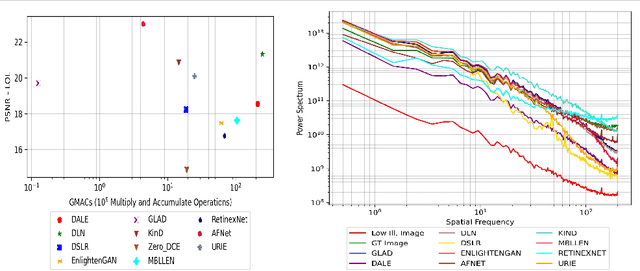
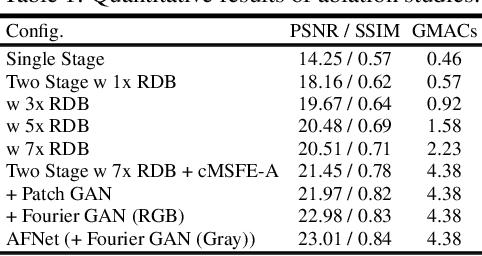
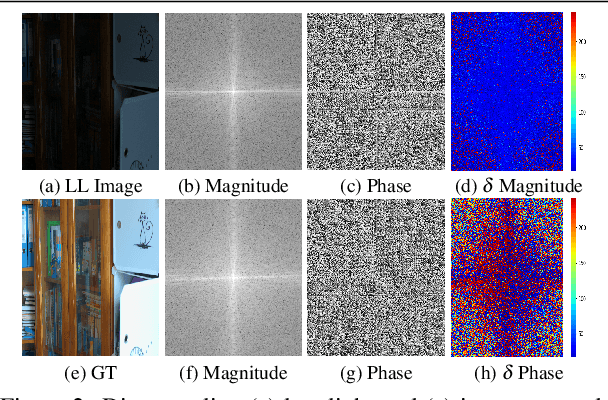
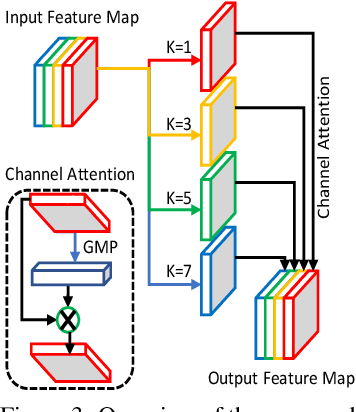
Abstract:The limited dynamic range of commercial compact camera sensors results in an inaccurate representation of scenes with varying illumination conditions, adversely affecting image quality and subsequently limiting the performance of underlying image processing algorithms. Current state-of-the-art (SoTA) convolutional neural networks (CNN) are developed as post-processing techniques to independently recover under-/over-exposed images. However, when applied to images containing real-world degradations such as glare, high-beam, color bleeding with varying noise intensity, these algorithms amplify the degradations, further degrading image quality. We propose a lightweight two-stage image enhancement algorithm sequentially balancing illumination and noise removal using frequency priors for structural guidance to overcome these limitations. Furthermore, to ensure realistic image quality, we leverage the relationship between frequency and spatial domain properties of an image and propose a Fourier spectrum-based adversarial framework (AFNet) for consistent image enhancement under varying illumination conditions. While current formulations of image enhancement are envisioned as post-processing techniques, we examine if such an algorithm could be extended to integrate the functionality of the Image Signal Processing (ISP) pipeline within the camera sensor benefiting from RAW sensor data and lightweight CNN architecture. Based on quantitative and qualitative evaluations, we also examine the practicality and effects of image enhancement techniques on the performance of common perception tasks such as object detection and semantic segmentation in varying illumination conditions.
DGSS : Domain Generalized Semantic Segmentation using Iterative Style Mining and Latent Representation Alignment
Feb 26, 2022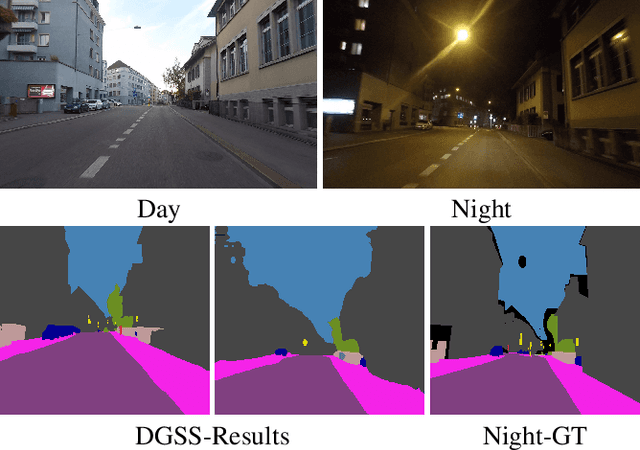

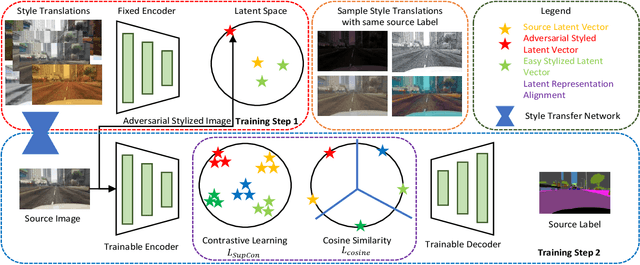

Abstract:Semantic segmentation algorithms require access to well-annotated datasets captured under diverse illumination conditions to ensure consistent performance. However, poor visibility conditions at varying illumination conditions result in laborious and error-prone labeling. Alternatively, using synthetic samples to train segmentation algorithms has gained interest with the drawback of domain gap that results in sub-optimal performance. While current state-of-the-art (SoTA) have proposed different mechanisms to bridge the domain gap, they still perform poorly in low illumination conditions with an average performance drop of - 10.7 mIOU. In this paper, we focus upon single source domain generalization to overcome the domain gap and propose a two-step framework wherein we first identify an adversarial style that maximizes the domain gap between stylized and source images. Subsequently, these stylized images are used to categorically align features such that features belonging to the same class are clustered together in latent space, irrespective of domain gap. Furthermore, to increase intra-class variance while training, we propose a style mixing mechanism wherein the same objects from different styles are mixed to construct a new training image. This framework allows us to achieve a domain generalized semantic segmentation algorithm with consistent performance without prior information of the target domain while relying on a single source. Based on extensive experiments, we match SoTA performance on SYNTHIA $\to$ Cityscapes, GTAV $\to$ Cityscapes while setting new SoTA on GTAV $\to$ Dark Zurich and GTAV $\to$ Night Driving benchmarks without retraining.
Correlate-and-Excite: Real-Time Stereo Matching via Guided Cost Volume Excitation
Aug 12, 2021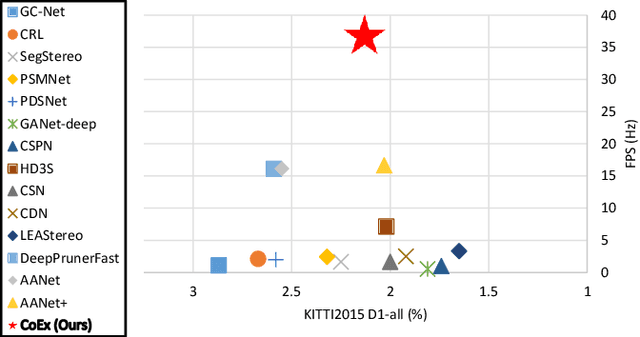



Abstract:Volumetric deep learning approach towards stereo matching aggregates a cost volume computed from input left and right images using 3D convolutions. Recent works showed that utilization of extracted image features and a spatially varying cost volume aggregation complements 3D convolutions. However, existing methods with spatially varying operations are complex, cost considerable computation time, and cause memory consumption to increase. In this work, we construct Guided Cost volume Excitation (GCE) and show that simple channel excitation of cost volume guided by image can improve performance considerably. Moreover, we propose a novel method of using top-k selection prior to soft-argmin disparity regression for computing the final disparity estimate. Combining our novel contributions, we present an end-to-end network that we call Correlate-and-Excite (CoEx). Extensive experiments of our model on the SceneFlow, KITTI 2012, and KITTI 2015 datasets demonstrate the effectiveness and efficiency of our model and show that our model outperforms other speed-based algorithms while also being competitive to other state-of-the-art algorithms. Codes will be made available at https://github.com/antabangun/coex.
Evaluating COPY-BLEND Augmentation for Low Level Vision Tasks
Mar 10, 2021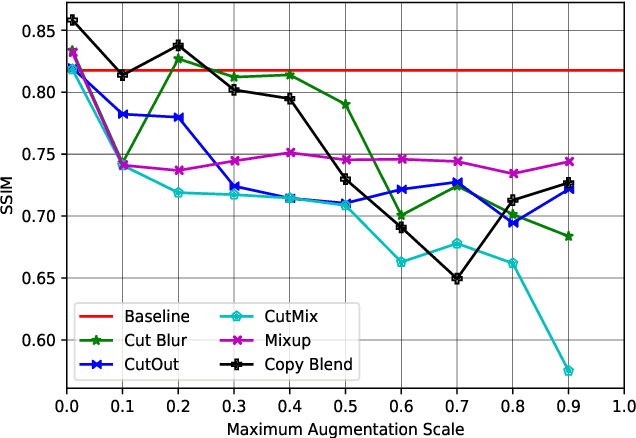
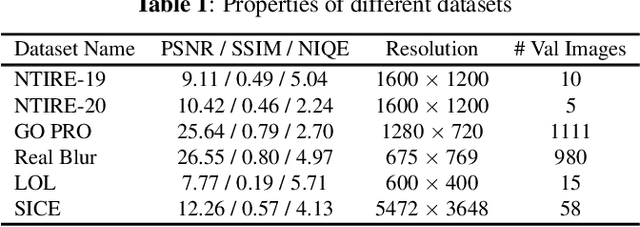

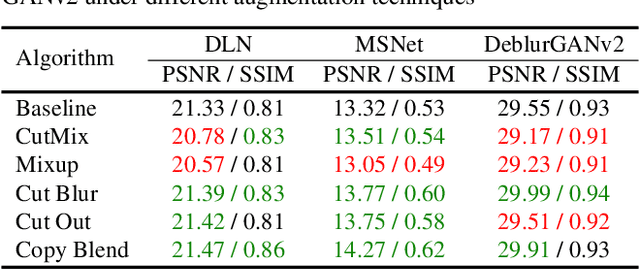
Abstract:Region modification-based data augmentation techniques have shown to improve performance for high level vision tasks (object detection, semantic segmentation, image classification, etc.) by encouraging underlying algorithms to focus on multiple discriminative features. However, as these techniques destroy spatial relationship with neighboring regions, performance can be deteriorated when using them to train algorithms designed for low level vision tasks (low light image enhancement, image dehazing, deblurring, etc.) where textural consistency between recovered and its neighboring regions is important to ensure effective performance. In this paper, we examine the efficacy of a simple copy-blend data augmentation technique that copies patches from noisy images and blends onto a clean image and vice versa to ensure that an underlying algorithm localizes and recovers affected regions resulting in increased perceptual quality of a recovered image. To assess performance improvement, we perform extensive experiments alongside different region modification-based augmentation techniques and report observations such as improved performance, reduced requirement for training dataset, and early convergence across tasks such as low light image enhancement, image dehazing and image deblurring without any modification to baseline algorithm.
 Add to Chrome
Add to Chrome Add to Firefox
Add to Firefox Add to Edge
Add to Edge